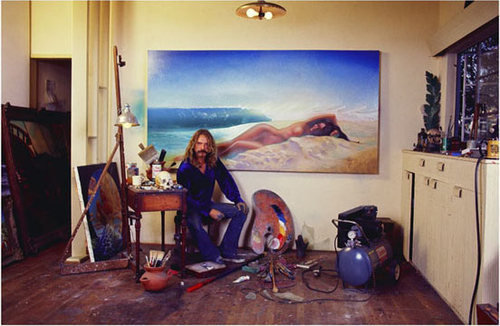Rick Griffin
dal 23/6/2007 al 29/9/2007
Segnalato da
23/6/2007
Rick Griffin
Laguna Art Museum, Laguna Beach
Transcendence. The exhibition includes 140 paintings, drawings, posters, album covers, and artifacts, surveys thirty years of the artist work from the 1960s until his death in 1991. The catalog addresses Griffin's impact on the surf, rock and Born Again Christian movements.

Transcendence
Rick Griffin (1944-1991), a cult figure who has set the iconographic terrain for three distinct subcultures, has had a significant impact on our culture overall. Heart and Torch: Rick Griffin’s Transcendence was organized by Laguna Art Museum and will be Griffin’s first major retrospective and first solo museum exhibition. The exhibition, which opens on June 24, 2007, and will include 140 paintings, drawings, posters, album covers, and artifacts, surveys thirty years of Griffin’s work from the 1960s until his death in 1991. The accompanying 156-page catalogue, published in association with Gingko Press, will be the first publication to address Griffin’s impact on the surf, rock and Born Again Christian movements.
Before Griffin begins to revel in the art and politics of the counterculture, he is a surfer. A teenager during the late 1950s and early 1960s, Griffin develops the well-known cartoon-strip character Murphy, which is regularly published in Surfer magazine (the preeminent surf magazine of the era), where Griffin becomes an art director at age 20. Though Mad magazine influences Griffin’s early work from this period, the artist’s innate graphic sensibilities immediately appeal to young surfers, setting into motion a new genre now recognized as the surf cartoon. Griffin’s defiant and mischievous cartoon character helps set the tone for the look and voice of the incipient surf culture.
Griffin is renowned as a “surfer artist” when he arrives in San Francisco in 1966, just in time to earn a poster commission for the first Human Be-In, setting into motion the Summer of Love. Creating a simple, yet powerful design for that event, he quickly makes a name for himself with his brilliant lettering, nineteenth-century graphics, breathtaking color combinations, and humorous approach to advertising motifs. Griffin’s new media is the psychedelic rock poster and his artwork permeates urban cores, where emerging bands that he designs for, such as Jimi Hendrix and the Grateful Dead, give concerts. In recognition of his growing influence Life magazine featured Griffin as one of the premier psychedelic artists of “The Great Poster Wave” sweeping the country in September 1967.
While Griffin establishes himself as a lucrative poster artist during the mid to late 1960s, he is simultaneously working as a preeminent artist in the underground comics’ scene. Along with Robert Crumb, Robert Williams, S. Clay Wilson, Stanley Mouse, Victor Moscoso, Kim Deitch, and Spain Rodriguez, he establishes the avant-garde Zap Comix.
As the heyday of the sixties is fading, Griffin moves back to Southern California where, in 1970, he is reborn in the Christian faith. As a Christian, Griffin takes a change of direction. He illustrates The Gospel of John and other faith-based work for the just-forming Calvary Chapel in Costa Mesa. However, when Griffin converts to Christianity, he does not completely leave behind his former life as a member of the psychedelic counterculture. The work he produces after his conversion reflects a mixture of lifestyles, as his new Christian imagery incorporates aspects of psychedelic art, including its intricate lettering and drug-related iconography. Griffin is one of the first artists to express his personal feelings toward Jesus without drawing on conventional iconography passed down from the Renaissance and Middle Ages.
The art of Rick Griffin, whether in cartoons for Surfer magazine, psychedelic posters, Zap Comix, or Christian imagery, mirrors the values and spiritual yearning of a whole generation of youth. Rick Griffin is killed at the age of 47 in August 1991 while riding his Harley Davidson motorcycle in Petaluma, California. The artist’s last published work in a San Francisco magazine seems to prophesy his early death. It is a self-portrait of him kneeling at Heaven's Gate with a pen and ink in his hand.
Heart and Torch is accompanied by a full-color catalogue with essays by Doug Harvey, Greg Escalante, Jacaeber Kastor, Chaz BojÓrquez, and with an interview with Chuck Fromm, and a chronology by Gordon McClelland.
Laguna Art Museum
307 Cliff Dr. - Laguna beach



